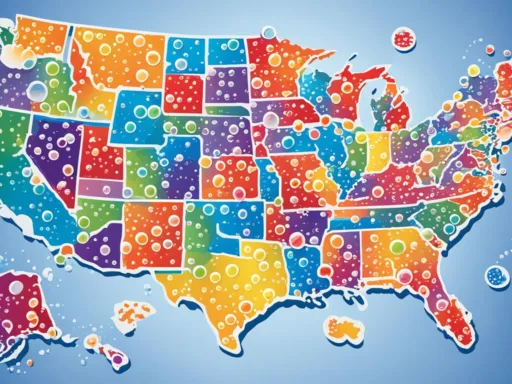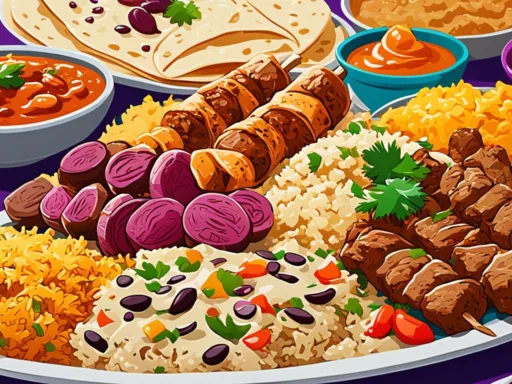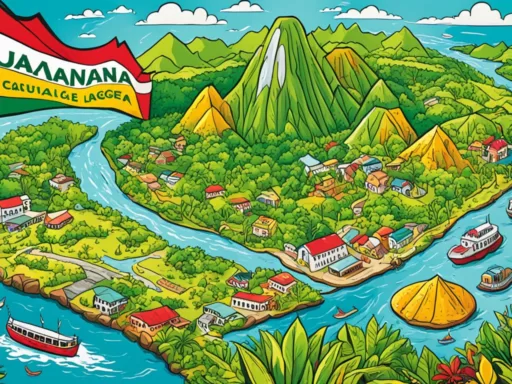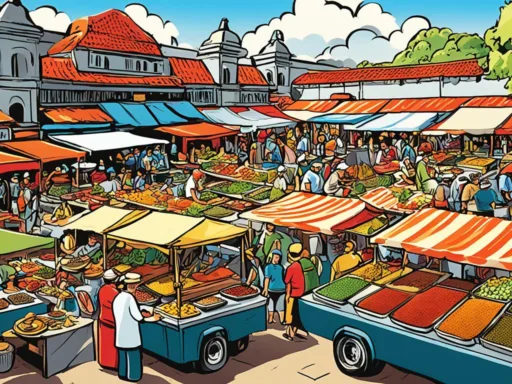The symphony of human speech is remarkably varied in Venezuela, a country where more than just a single official language thrives. In the bustling marketplaces of Maracaibo to the verdant stretches of the Orinoco, the languages spoken in Venezuela paint an intricate portrait of the nation’s cultural wealth. Staggeringly, the 2011 Venezuelan census cataloged around 50 major indigenous groups, each with its unique tongue, embroidering the vast linguistic diversity of this vibrant nation.
While Spanish reigns as the preeminent language, knitted into every sector of Venezuelan life, there exists an impressive quilt of indigenous languages Venezuela proudly upholds as facets of its cultural identity. From the Wayuu language, echoing in the voices of over 348,000 speakers, to the melodic cadences of Warao and Pemón, this linguistic diversity is not just a fact of life—it’s an official state policy. In a country where urban centers usually resonate with the sounds of Spanish, rural regions and select cities like Maracaibo hold strong as bastions of indigenous vernaculars.
The country’s commitment to its linguistic landscape is more than just rhetoric; it’s an integral part of the policies shaping education and literacy programs among these treasured communities. So, let’s embark on a journey to unfurl the vibrant linguistic map that is home to the official languages Venezuela celebrates, and discover the dynamic interplay between language, culture, and identity.
Key Takeaways
- Spanish is the prevalent official language of Venezuela, but the linguistic scene is far more complex and diverse.
- Around 50 indigenous languages are recognized as part of Venezuela’s linguistic diversity, with Wayuu, Warao, and Pemón being the most spoken.
- Spanish is the mainstay in urban areas, while indigenous languages are more common in rural regions and certain cities like Maracaibo.
- The Venezuelan constitution ensures that indigenous languages Venezuela sustains are not only protected but celebrated as part of the nation’s cultural identity.
- Census data and educational policy adjustments provide a continually updated understanding of language use across the country.
An Overview of Venezuela’s Linguistic Landscape
Venezuela presents a complex tapestry of languages that reflects its rich history and cultural composition. At the heart of this linguistic diversity is Spanish, which serves myriad roles within the nation—from the official language of administration to the everyday vernacular for communication among its citizens. However, beneath this seemingly homogenous linguistic surface lies a multitude of languages that add to the nation’s cultural wealth and embody its commitment to linguistic plurality.
The Prevalence of Spanish as the Dominant Language
While Spanish, with its various dialects, undeniably underpins the communication framework in Venezuela, it is the nuances of these local Spanish dialects of Venezuela that offer insight into the country’s multifaceted linguistic identity. From the coastal regions to the Andean highlands, each dialect serves as a living testament to the historical currents that have shaped the country’s linguistic landscape.
Linguistic Diversity Beyond the Official Language
- Linguistic diversity in Venezuela is not merely a sum of separate languages but a symbiotic ecosystem wherein languages influence and borrow from one another.
- Indigenous languages flourish throughout the nation, each recognized within its community, often holding the key to unique worldviews and knowledge systems intrinsic to Venezuela’s cultural heritage.
- These languages span a gamut from the widely spoken Wayuu to the lesser-known but equally important Pemón and Warao.
The Intersection of Language and Cultural Identity
The interconnection between language and identity in Venezuela is undeniable. In many municipalities, the primary indigenous language forms the core of the community’s identity, channels of cultural expression and continuity. Efforts to preserve these languages are not merely about maintaining communication but also about safeguarding the cultural identity through language that these tongues encapsulate.
| Region | Primary Language | Cultural Significance |
|---|---|---|
| Zulia | Wayuu | Artisanal crafts, traditional music, and oral traditions |
| Delta Amacuro | Warao | Relationship with the riverine ecosystem, canoe craftsmanship |
| Bolívar | Pemón | Tepui legends, eco-spiritual practices |
The Official Language of Venezuela: Spanish and Its Variants
While Spanish holds the official status in the Venezuelan Constitution, the linguistic framework of the nation is far from homogenous. With various regional dialects sprouting from distinct local customs and historical developments, Venezuela’s linguistic identity is as diverse as its landscape. The official languages of Venezuela play a significant role in expressing national unity and cultural identity, honoring a linguistic diversity that is both respected and protected by law.
Regional Spanish Dialects Within Venezuela
Intriguingly, the Spanish spoken in Venezuela is characterized by regional variations that provide a unique spin on the classic language. These regional Spanish dialects not only add color to Venezuela’s verbal communication but also mirror the rich tapestry of the nation’s history and social nuances. From the Caribbean coastline to the Andean highlands, the Spanish language bends and adapts, creating a symphony of dialects that contribute vitally to the country’s linguistic patrimony.
The Impact of Venezuelan Spanish on National Unity
Language is more than a tool for communication—it is a vehicle for unity and identity. In Venezuela, Spanish serves as a vital component fostering national unity through language, bridging cultural gaps and reinforcing a sense of common identity amongst its people. Despite the inherent diversity of dialects and linguistic nuances across the country, it is the shared understanding and use of Spanish that solidifies the bonds of nationhood, unifying Venezuelans under one linguistic banner.
| Region | Unique Characteristics | Influence on National Unity |
|---|---|---|
| Caribbean Coast | Aspiration of syllable-final ‘s’; lively intonation | Highlighting the coastal heritage and shared festive spirit |
| Andean Highlands | Conservative pronunciation; influence of indigenous languages | Preservation of traditional values and historical roots |
| Los Llanos | Strong intonation; slower pace of speech | Emphasizing the serene and expansive nature of the plains |
| Central Region | Urbanized accent; fast-paced and modern | Reflecting the bustling life of metropolitan centers |
Indigenous Languages and Their Role in Venezuelan Society
Venezuela’s cultural patrimony is profoundly enriched by its indigenous languages. These languages not only form a bridge to the country’s ancestral past but also continue to play a pivotal role in shaping the cultural narratives of today’s society. The constitutional recognition of approximately 70 indigenous languages is a testament to their importance within the nation’s cultural matrix. Diverse language families such as Arawakan, Cariban, and Chibchan represent the linguistic variety that exists and is celebrated within Venezuela.

Language acts as a cornerstone in Venezuelan indigenous communities, intricately tied to traditional and cultural practices. This complex relationship showcases the necessity for bilingualism and multilingual education programs that honor and sustain linguistic diversity. Indigenous languages in Venezuela are not merely means of communication; they are the lifeblood of cultural heritage and are integral to the identity of their speakers.
Venezuela sees its indigenous languages as the soul of the nation, an essential part of who we are and where we come from. They enrich our cultural tapestry and strengthen our sense of identity.
The following table highlights some of the prominent indigenous languages of Venezuela, reflecting the wealth of linguistic diversity in the country:
| Language Family | Indigenous Language | Number of Speakers (approx.) |
|---|---|---|
| Arawakan | Wayuu | 348,000 |
| Cariban | Pemón | 30,000 |
| Chibchan | Barí | 6,000 |
| Saliban | Piaroa | 14,000 |
| Yanomaman | Yanomami | 20,000 |
The multiplicity of indigenous languages in Venezuela does more than just add to the country’s cultural complexity; it serves as a beacon of its cultural patrimony. As members of society, we are urged to not only recognize but also to protect and promote the invaluable resource that is indigenous languages Venezuela.
Languages Spoken Venezuela: A Closer Look at Minority Languages
Venezuela’s rich cultural fabric is interwoven with the threads of numerous indigenous tongues, some of which are teetering on the edge of oblivion. The preservation of these minority languages in Venezuela is not just about safeguarding words and grammar; it’s about maintaining the cultural identity and the very soul of the communities that speak them.
Endangered Languages and the Efforts to Preserve Them
In an effort to protect these irreplaceable cultural assets, organizations and academic circles have mobilized to document and promote the endangered languages of Venezuela. Meticulously, researchers are racing against time to compile dictionaries and grammar guides, set up language courses, and record the oral histories of the elders—a key initiative in ensuring these languages do not fade into silence.
Popular Indigenous Languages: Wayuu, Warao, and Pemón

The Wayuu, Warao, and Pemón languages stand out in the Venezuelan linguistic landscape for their relatively robust number of speakers compared to other indigenous tongues. The importance of these languages extends beyond communication—they are emblematic of the collective memory and wisdom of their respective cultures. International recognition, such as UNESCO’s nod towards the revitalization of languages like Mapoyo, underscores the global significance of this endeavor.
Despite the encroaching pressures of urban migration that threaten the continuation of these languages, the resolve to keep them alive remains strong. Academic contributions towards their preservation and the resilience of speaking communities themselves offer a beacon of hope for the future of these vital cultural cornerstones.
Charting the Venezuelan Language Map: Distribution and Usage
The fabric of Venezuela’s linguistic identity is colored by its diverse language distribution, where particular areas are notable for their concentration of indigenous language speakers. This intricate Venezuelan language map portrays the cultural resilience manifesting in languages that have withstood the test of urbanization influence on language. Cities have typically been the engines of linguistic homogenization, yet Venezuela demonstrates fascinating exceptions to this trend.
Geographical Pockets of Indigenous Language Speakers
Despite a national prevalence of Spanish, certain Venezuelan states and municipalities are bastions of indigenous linguistic heritage. Languages such as Wayuu, Piaroa, and Yanomami, each continue to be the primary medium of communication for significant populace segments, often in more isolated or rural locations.
The Influence of Urbanization on Language Distribution
Urban centers have played a pivotal role in shaping language use in Venezuela. The movement into such areas generally corresponds with an increase in Spanish language adoption, leading some indigenous languages to experience shift or attrition. In spite of this, a small number of cities, like Maracaibo, are vibrant hosts to indigenous linguistic traditions offering a counter-narrative to the norm of urban language homogeneity.
| State/Municipality | Indigenous Language | % of Language Speakers | Notes |
|---|---|---|---|
| Zulia | Wayuu | 60% | High in both rural and urban areas |
| Amazonas | Piaroa | 80% | Concentrated in rural communities |
| Bolívar | Yanomami | 70% | Largely isolated, some urban clusters |
| Maracaibo | Various | Varies | Urban exception with Indigenous persistence |

Literacy and Education Among Indigenous Language Speakers
Delving into the heart of Venezuela’s educational landscape, one finds a nuanced picture of literacy rates and educational achievements among indigenous language speakers. Studies underscore the critical role that targeted educational programs play in bolstering literacy rates within these communities. These initiatives, often embracing bilingual and intercultural approaches, strive to enhance literacy rates in Venezuela while preserving the linguistic heritage of its indigenous populations.
The educational framework tailored for speakers of indigenous languages is not uniform across Venezuela. Instead, it reflects a responsiveness to the unique needs and languages of each indigenous community. The following table presents an overview of the literacy levels among select indigenous groups and the educational strategies implemented in their respective communities to promote both literacy and language retention.
| Indigenous Group | Literacy Rate | Educational Focus |
|---|---|---|
| Waikeri | Above national average | Bilingual education programs |
| Baré | Above national average | Intercultural education initiatives |
| Wayuu | Varies regionally | Literacy enhancement via community schools |
| Pemón | Improving steadily | Cultural preservation through educational materials in Pemón |
| Warao | Below national average | Development of literacy resources in Warao language |
An interesting observation is that the Waikeri and Baré communities, due to their bilingual education strategies, display literacy rates that are higher than the national average, indicating a successful intersection of educational approaches with language conservation. Conversely, the Warao community’s literacy rates fall beneath the average, suggesting a pressing need for supportive educational measures tailored to their language and culture.
Beyond the auspices of formal education, it is vital to acknowledge the community-driven efforts that play an indispensable role in sustaining the educational momentum within indigenous language contexts. Local leaders and educators often spearhead projects to develop learning materials, carry out literacy workshops, and facilitate a conducive environment for language acquisition among both the young and adult population.
Venezuelan Sign Language and Its Recognition
In the quest for comprehensive communication accessibility in Venezuela, Venezuelan Sign Language (LSV) emerges as a fundamental channel for the deaf community to engage with society. While LSV is not formally established as an official language, it enjoys protection under constitutional articles that cement the communication rights of the deaf community. This recognition underscores the importance of including diverse methods of communication within the country’s commitment to accessibility and equal opportunities for all its citizens.
In order to facilitate understanding and appreciation for LSV’s role in Venezuelan society, the following table provides insight into its presence within various public sectors:
| Sector | Usage of Venezuelan Sign Language | Impact on Communication Accessibility |
|---|---|---|
| Education | LSV integrated into special education curriculums and sign language programs | Enables deaf students to receive an inclusive education |
| Television Media | Mandated content in LSV on public and private television | Improves information access for the deaf community |
| Government Services | Interpreters available for official proceedings and services | Facilitates civic engagement and access to government support |
| Cultural Events | LSV interpretation available for performances and public events | Promotes cultural inclusivity and participation |
Emphasizing the impact of LSV within Venezuela, it serves as a testament to the nation’s dedication to fostering an environment where every individual, irrespective of hearing capacity, is acknowledged and provided with the resources necessary to thrive. Effective communication is paramount, and the strides in Venezuelan Sign Language advocacy highlight significant progress towards a more inclusive society.
Every individual has the right to communicate and access information in the manner most effective for them, and Venezuelan Sign Language is a vital part of ensuring that the deaf community is not left behind.
Venezuelan Sign Language’s evolving presence across various sectors is not just about language preservation; it’s about acknowledging and valuing the rich tapestry of human interaction. With each gesture and sign, LSV breaks down barriers and weaves deaf individuals more tightly into the social fabric of Venezuela, establishing communication accessibility as a right rather than a privilege.
Impact of Immigration on the Linguistic Diversity of Venezuela
As waves of immigrants have reached the shores of Venezuela, they’ve brought with them a mosaic of melodies in the form of languages that have since woven their way into the fabric of Venezuelan culture. The influence of immigration in Venezuela is profound, introducing European and Asian languages that have burst onto the scene, bringing with them a diverse cultural heritage and linguistic complexity. This integration has painted a vibrant and dynamic linguistic landscape that speaks to the historical and contemporary migration trends, making Venezuela home to an even richer cultural and linguistic diversity.
Influence of European Languages: Italian, Portuguese, and German
Over the years, European languages in Venezuela have made their mark through communities that trace their roots back to the Old Continent. Italian, Portuguese, and German are notable examples, echoing the lineage of European migrants who have settled in Venezuela and shared their linguistic heritage. Their languages serve as a bridge between past and present, contributing to the cultural texture of Venezuelan society and persisting as a testament to the enduring impact of European immigration on the nation’s identity.
Asian Languages in Venezuela: Chinese and Its Cultural Significance
Moving from Europe to Asia, the Chinese community in Venezuela stands out with a significant number of speakers, estimated to be around 400,000. The presence of Asian languages in Venezuela, particularly Chinese, underscores yet another layer of this country’s linguistic diversity. Embracing the cultural significance and traditions linked with these languages is more than just an inclusion of words and grammar; it reflects the shared human experiences that come from far and wide to find a new voice in Venezuela. The tapestry of languages, enriched by global narratives, continues to shape the kaleidoscopic cultural identity of Venezuela today.






